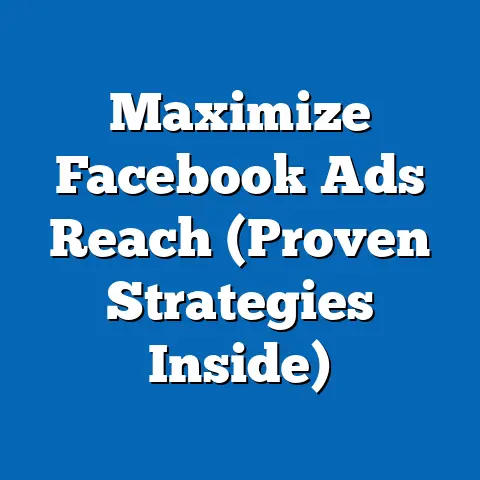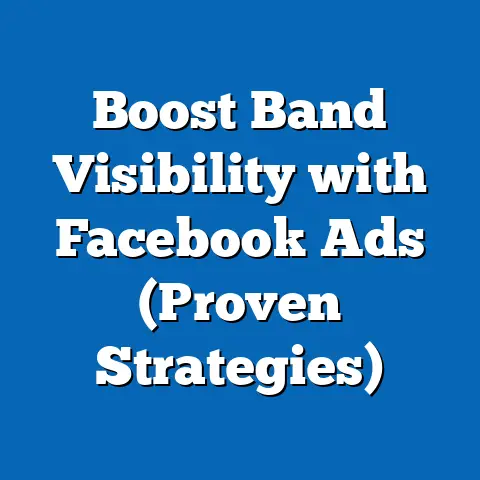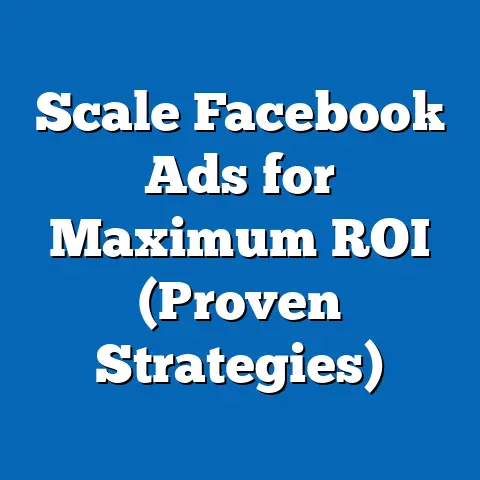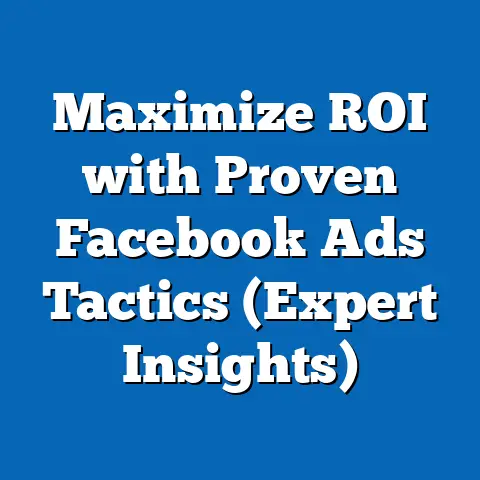Master Facebook Ads Sizes (Critical Design Insights)
As autumn leaves begin to fall and the aroma of pumpkin spice fills the air, businesses everywhere gear up for one of the most crucial times of the year: the holiday season. From Halloween candy promotions to Thanksgiving feasts and the frenzy of Black Friday, the next few months are packed with opportunities to connect with customers and drive sales. But in the crowded digital landscape, standing out from the noise requires more than just a great product; it demands a savvy advertising strategy. And at the heart of that strategy lies a seemingly simple, yet incredibly powerful element: Facebook ad sizes.
I’ve seen firsthand how the correct ad sizes can transform a campaign from a budget drain to a revenue generator. Think of it like choosing the right frame for a masterpiece. A poorly sized or mismatched frame can detract from the art, while the perfect frame enhances its beauty and draws the eye. The same principle applies to your Facebook ads. Using the right dimensions ensures your message is seen, understood, and acted upon.
In this article, I’m going to walk you through the ins and outs of Facebook ad sizes, with a particular focus on how to leverage them for seasonal campaigns. I’ll share critical design insights that will help you optimize your ads for maximum impact, ensuring your message resonates with your audience during these important times of the year. Get ready to learn how to make your Facebook ads the star of the show this season!
Understanding Facebook Ad Sizes
What exactly are Facebook ad sizes, and why are they so vital? In essence, they refer to the specific dimensions and specifications required for different ad formats on the Facebook platform. Just like a tailor needs precise measurements to create a well-fitting garment, you need to adhere to Facebook’s ad size guidelines to ensure your ads display correctly and effectively.
The importance of ad sizes stems from several factors:
- Visual Appeal: Properly sized ads look professional and polished, grabbing attention and conveying a sense of quality.
- Optimal Display: The right dimensions prevent distortion, cropping, or other visual issues that can detract from your message.
- User Experience: Ads that fit seamlessly into the Facebook feed or Stories provide a more enjoyable and engaging experience for users.
- Platform Compliance: Facebook has strict guidelines, and non-compliant ads may be rejected or penalized, impacting your campaign performance.
Over the years, I’ve learned that ignoring ad size specifications is a surefire way to waste your advertising budget. I once worked with a client who insisted on using the same image asset across all their platforms, regardless of size requirements. The result? Their Facebook ads were consistently cropped in awkward ways, cutting off key elements of their message. It was a costly lesson in the importance of adhering to platform-specific guidelines.
Here’s a breakdown of the most common Facebook ad sizes you should be familiar with:
- Feed Ads (Image and Video):
- Recommended Image Size: 1080 x 1080 pixels (square)
- Minimum Image Size: 600 x 600 pixels
- Aspect Ratio: 1:1
- Video: Recommended resolution of 1080 x 1080 pixels with a maximum file size of 4GB.
- Stories Ads:
- Recommended Image Size: 1080 x 1920 pixels (vertical)
- Aspect Ratio: 9:16
- Video: Same specifications as image ads, with a maximum duration of 120 seconds.
- Carousel Ads:
- Recommended Image Size: 1080 x 1080 pixels
- Aspect Ratio: 1:1
- Minimum Cards: 2
- Maximum Cards: 10
- Collection Ads:
- Recommended Image Size (Hero Image): 1080 x 1080 pixels
- Aspect Ratio: 1:1
- Video: Same specifications as feed ads.
- Instant Experience Ads:
- Recommended Image Size: 1080 x 1920 pixels
- Aspect Ratio: Varies depending on the template used.
- Recommended Image Size: 1080 x 1080 pixels (square)
- Minimum Image Size: 600 x 600 pixels
- Aspect Ratio: 1:1
- Video: Recommended resolution of 1080 x 1080 pixels with a maximum file size of 4GB.
- Recommended Image Size: 1080 x 1920 pixels (vertical)
- Aspect Ratio: 9:16
- Video: Same specifications as image ads, with a maximum duration of 120 seconds.
- Recommended Image Size: 1080 x 1080 pixels
- Aspect Ratio: 1:1
- Minimum Cards: 2
- Maximum Cards: 10
- Recommended Image Size (Hero Image): 1080 x 1080 pixels
- Aspect Ratio: 1:1
- Video: Same specifications as feed ads.
- Recommended Image Size: 1080 x 1920 pixels
- Aspect Ratio: Varies depending on the template used.
It’s also worth noting that Facebook is constantly updating its ad specifications, so it’s crucial to stay informed. Always refer to the official Facebook Ads Guide for the most up-to-date information.
Takeaway: Understanding and adhering to Facebook ad size guidelines is essential for creating visually appealing, effective ads that comply with platform requirements.
Seasonal Ad Size Strategies
Seasonal marketing campaigns are all about capturing the spirit of the moment. Whether it’s the festive cheer of the holidays or the sun-soaked vibes of summer, your ads should reflect the current season and resonate with the emotions and expectations of your target audience. And that includes considering the right ad sizes.
Why does ad size matter in seasonal campaigns?
- Enhanced Visual Impact: Using the right sizes ensures your seasonal imagery and messaging are displayed in their best light, grabbing attention and creating a memorable impression.
- Optimized Mobile Experience: With a large portion of Facebook users accessing the platform on mobile devices, it’s crucial to prioritize mobile-friendly ad sizes like Stories ads, which take up the entire screen.
- Increased Engagement: Ads that seamlessly integrate into the user’s feed or Stories are more likely to be viewed, clicked, and shared.
Let’s look at some examples of how you can tailor your ad sizes for specific seasonal themes:
- Holiday Sales: For holiday campaigns like Black Friday or Christmas, consider using carousel ads to showcase multiple products or gift ideas. The square format (1080 x 1080 pixels) works well for displaying product images and descriptions.
- Summer Promotions: For summer campaigns, Stories ads (1080 x 1920 pixels) can be highly effective. Use vibrant, high-resolution images or videos that capture the essence of summer, such as beach scenes, outdoor activities, or refreshing beverages.
- Back-to-School: Collection ads are a great option for back-to-school campaigns, allowing you to showcase a range of school supplies, clothing, and accessories. The hero image can feature a student or a classroom scene, while the smaller product images highlight specific items.
- Halloween: Halloween campaigns can benefit from visually striking image ads that incorporate spooky imagery, such as pumpkins, ghosts, or costumes. Use the feed ad format (1080 x 1080 pixels) to create eye-catching visuals that stand out in the user’s feed.
One of the most successful seasonal campaigns I’ve worked on involved a local bakery promoting their Thanksgiving pies. We used a combination of feed ads and Stories ads, featuring mouthwatering images of their pies against a backdrop of autumn leaves and cozy interiors. The key was to use high-quality visuals that captured the warmth and nostalgia of the holiday season. We also A/B tested different ad sizes and messaging to optimize for engagement and conversions.
When selecting the right ad type and size, consider the following:
- Your Product or Service: What are you promoting? Does it lend itself to visual storytelling or a product catalog?
- Your Target Audience: Who are you trying to reach? What are their preferences and behaviors?
- Your Campaign Goals: What do you want to achieve? Are you aiming for brand awareness, website traffic, or sales conversions?
Takeaway: Tailor your Facebook ad sizes to suit the specific seasonal theme and your campaign goals. Prioritize mobile-friendly formats like Stories ads and use high-quality visuals that resonate with your target audience.
Design Insights for Effective Ads
While choosing the right ad size is crucial, it’s only half the battle. The design of your ad is equally important in capturing attention, conveying your message, and driving conversions. Here are some critical design insights to keep in mind:
- Importance of Visual Hierarchy: Visual hierarchy refers to the arrangement of elements within your ad to guide the viewer’s eye and emphasize key information. Use size, color, and placement to create a clear hierarchy that highlights the most important aspects of your message. For example, make your headline larger and bolder than your body text, and place your call-to-action button in a prominent location.
- Color Psychology: Colors evoke emotions and associations, so choose them wisely. For seasonal campaigns, consider using colors that align with the theme. Warm colors like red, orange, and yellow are often used for fall and Thanksgiving campaigns, while cool colors like blue, green, and white are associated with winter and the holiday season.
- Typography: Your font choices can significantly impact the readability and overall aesthetic of your ad. Choose fonts that are easy to read and that align with your brand’s personality. Use different font sizes and weights to create visual interest and emphasize key information.
- Use of Imagery: High-quality visuals are essential for capturing attention and conveying your message. Use images or videos that are relevant to your product or service and that resonate with your target audience. For seasonal campaigns, incorporate imagery that reflects the current season, such as holiday decorations, summer landscapes, or autumn foliage.
I’ve found that paying attention to these design details can make a huge difference in the performance of your ads. I once worked with a client who was struggling to get traction with their holiday campaign. Their ads were visually cluttered and lacked a clear message. By simplifying the design, improving the visual hierarchy, and incorporating more festive imagery, we were able to significantly increase their engagement and conversion rates.
Another important tip is to keep your ads consistent with your brand’s overall aesthetic. Use the same colors, fonts, and imagery that you use on your website and other marketing materials. This will help reinforce your brand identity and create a cohesive experience for your customers.
Takeaway: Focus on creating visually appealing ads that incorporate strong visual hierarchy, strategic color choices, readable typography, and high-quality imagery. Keep your ads consistent with your brand’s overall aesthetic.
Testing and Optimization
No matter how well you plan your seasonal campaigns, there’s always room for improvement. That’s where testing and optimization come in. By A/B testing different ad sizes and designs, you can identify what works best for your target audience and continuously improve your campaign performance.
Here are some key aspects of testing and optimization:
- A/B Testing: A/B testing involves creating two or more versions of your ad (A and B) and running them simultaneously to see which one performs better. You can test different ad sizes, headlines, images, call-to-action buttons, and targeting options.
- Facebook Ads Manager Analytics: Facebook’s Ads Manager provides a wealth of data that you can use to analyze the performance of your ads. Pay attention to metrics like reach, impressions, clicks, conversions, and cost per result.
- Iterative Design: Based on your performance data, iterate on your ad designs to continuously improve engagement and conversion rates. Try different variations of your ads and track their performance over time.
I’ve learned that testing is an ongoing process. What works today may not work tomorrow, so it’s important to continuously experiment and adapt your strategies. I recommend setting up a system for tracking your ad performance and regularly reviewing your data.
Here are some specific tips for testing and optimizing your Facebook ads:
- Start with a Hypothesis: Before you start testing, develop a clear hypothesis about what you expect to happen. For example, “I believe that using a larger image size will increase click-through rates.”
- Test One Variable at a Time: To accurately measure the impact of each variable, test only one element at a time. For example, test different image sizes while keeping the headline and call-to-action button the same.
- Track Your Results: Use Facebook Ads Manager to track your results and identify which versions of your ads are performing best.
- Make Data-Driven Decisions: Base your decisions on the data you collect. If one version of your ad is consistently outperforming the others, scale up your investment in that version.
Takeaway: Testing and optimization are essential for maximizing the performance of your Facebook ads. Use A/B testing to experiment with different ad sizes and designs, and analyze your performance data to identify what works best for your target audience.
Conclusion
Mastering Facebook ad sizes is a critical skill for any marketer looking to succeed in today’s competitive digital landscape. Especially when you’re trying to capture the attention of holiday shoppers or summer vacation planners, you need to make sure your ads are not only seen but also resonate with your audience. By understanding the different ad formats, tailoring your ad sizes to suit the seasonal theme, and focusing on effective design principles, you can create Facebook ads that stand out from the crowd and drive meaningful results.
Remember, the key takeaways from this article are:
- Adhere to Facebook’s ad size guidelines to ensure your ads display correctly and effectively.
- Tailor your ad sizes to suit the specific seasonal theme and your campaign goals.
- Focus on creating visually appealing ads that incorporate strong visual hierarchy, strategic color choices, readable typography, and high-quality imagery.
- Test and optimize your ads continuously to identify what works best for your target audience.
With these insights in mind, I encourage you to experiment with your Facebook ads this season. Try different ad sizes and designs, and track your results to see what works best for your business. With a little creativity and a data-driven approach, you can create Facebook ads that capture the spirit of the season and drive significant results for your business. Now go out there and make your Facebook ads the star of the show!






